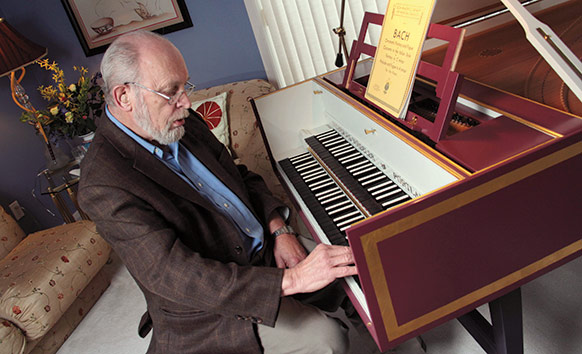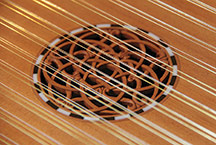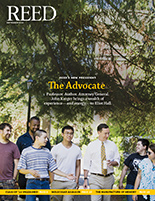
IRIS login | Reed College home Volume 91, No. 3: September 2012
Eliot Circular
Wheeler Unveils Harpsichord, 26 Years Later

rofessor Nick Wheeler, at home with the harpsichord he built over a span of 26 years. Photos by Vern Uyetake
Physics prof presents musical masterpiece at Reunions 2012.
By Nisma Elias ’12

The rosette is carved from Swiss pear wood with an inlay of ebony and ivory.
Alumni from many eras gathered in the Douglas F. Cooley Memorial Art Gallery during Reedfayre to witness a unique occasion—the unveiling of a French double harpsichord built by professor Nick Wheeler ’55 [physics 1963–2010] and a performance on it by Bonnie Garrett [private music 1988–2010].
“This is a Reed instrument and its first public appearance. It’s something I’ve fantasized about for 60 years,” Nick remarked at the event.
Nick became fascinated by the harpsichord (the distinguished ancestor of the piano) while playing at a concert during his freshman year at Reed and resolved to build his own instrument one day. He began work in 1985, when he was A.A Knowlton Professor of Physics. While the bulk of the carpentry and metalwork were completed in the two years that followed, the venture languished for two decades, as his teaching and other things took greater precedence. Nick was not able to put finishing touches on the instrument until his retirement.
Returning students and friends continued to ask over the years when and if the project would ever be finished. “It is a doubt which, I confess, I sometimes shared: it gave me anxiety because I did not want to leave to my heirs the problem of figuring out how to dispose of a stringless box that looked like a harpsichord, but was unplayable.” However, friends such as Professor Kathleen Worley [theatre 1985–] helped along the way by picking up some gold-dipped hardware and wood scrapers.
The case of the instrument is painted a shade of plum, while the support trestle and bench are eggplant, intended to make the instrument “seem to sit like a flower at the top of an unobtrusive stem.” Reversing the polarity of the piano keyboard, the natural keys are made of black ebony, while the sharps and flats are made of white bone. A range of woods, such as birch, poplar, plywood, maple, and ebony—some of which was salvaged from the old pipe organ in the Eliot Hall chapel—makes up the body of the harpsichord. The rosette, which serves no acoustic purpose but traditionally occupies a position in the middle of the soundboard, has six interwoven circles and is carved from Swiss pear wood with an inlay of ebony and ivory. The lustrous golden leaf on the name board was designed by Lee Littlewood ’68, a professional sign painter, who studied calligraphy with Lloyd Reynolds [English & art 1929–69].
Bonnie taught piano and harpsichord at Reed and also witnessed the humble beginnings of the instrument.
“When I heard Nick was building a double harpsichord (a harder task than just a single harpsichord), I wondered ‘How is he doing this? While being at Reed and a full-time professor?’ Then when I saw his tools and wood shavings in his office, I thought the physics department was a wonderful place.”
She awed the audience with three short scores by FranÇois Couperin, which introduced the audience to the color and possibilities of the two keyboards. Four compositions of another famous harpsichordist, J.S. Bach, served to demonstrate the range of dynamics of the five-octave keyboards; these were followed by the textured and elegant work by Jacques Duphly.
After giving the performance a thunderous applause, alumni took time to admire the harpsichord and to ask questions of both Nick and Bonnie. The harpsichord, which now resides in Nick’s home, may be on loan to the Portland Baroque Orchestra and to the Portland Opera from time to time, or may make an appearance in another concert. Nick’s symphony of dedication to the instrument will doubtless reverberate in the notes that it sounds in all the years to come.


LATEST COMMENTS
steve-jobs-1976 I knew Steve Jobs when he was on the second floor of Quincy. (Fall...
Utnapishtim - 2 weeks ago
Prof. Mason Drukman [political science 1964–70] This is gold, pure gold. God bless, Prof. Drukman.
puredog - 1 month ago
virginia-davis-1965 Such a good friend & compatriot in the day of Satyricon...
czarchasm - 4 months ago
John Peara Baba 1990 John died of a broken heart from losing his mom and then his...
kodachrome - 7 months ago
Carol Sawyer 1962 Who wrote this obit? I'm writing something about Carol Sawyer...
MsLaurie Pepper - 8 months ago
William W. Wissman MAT 1969 ...and THREE sisters. Sabra, the oldest, Mary, the middle, and...
riclf - 10 months ago